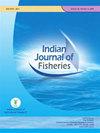Classical morphology and DNA barcoding based identification of freshwater ectoparasite, Argulus foliaceus in rohu Labeo rohita
IF 0.3
4区 农林科学
Q4 FISHERIES
引用次数: 0
Abstract
DNA barcoding coupled with classical morphological description have become promising approach for the species levelidentification. In the present study, 278 numbers of rohu Labeo rohita were screened, for Argulus infestation, amongwhich 167 fish (60.07%) were found infested with Argulus. Morphological attributes of the parasites were studied by lightmicroscope (LM) and Scanning Electron Microscope (SEM) which showed dorsoventrally flattened body comprising ofhead, thorax, abdomen, a pair of large compound eyes, suctorial organs with sclerotised support structures and two openingsof spermatheca at posterior end. Posterior incision of abdomen do not reach the mid-line and the cephalo-thoracic carapacehave not extended beyond the beginning of abdomen. Further validation was done using molecular tools for accurateparasite identification. The pair-wise genetic distance value, using Kimura-2 parameter showed a species level variationof 0.001 (1%) with that of A. foliaceus, while 0.083 and 0.052 (i.e. more than 2%) with that of A. indicus and A. japonicusrespectively. Phylogenetic tree generated using Neighbour-Joining (NJ) and Maximum-Likelihood (ML) methods, withKimura-2 parameter were also in agreement with pairwise distance values. The mitochondrial cytochrome c oxidase subunit1 (COI) sequences of A. foliaceus formed one cluster with the present studied samples, whereas sequences of A. japonicusformed a sister group. Integrating morphological and rapid DNA barcoding tools, the species was delineated as A. foliaceus. Keywords: Argulus foliaceus, COI gene, DNA barcoding, Labeo rohita, Morphology罗氏沼虾淡水外寄生虫叶阿格的经典形态学和DNA条形码鉴定
DNA条形码与经典形态学描述相结合已成为物种水平鉴定的一种很有前途的方法。在本研究中,对278只罗湖白鳍豚进行了阿格鲁感染筛查,其中167条鱼(60.07%)感染了阿格鲁。用光学显微镜(LM)和扫描电子显微镜(SEM)对寄生虫的形态特征进行了研究,结果表明,寄生虫的身体由头部、胸部、腹部、一对大型复眼、支撑结构硬化的吸液器和后端的两个受精囊开口组成。腹部后切口未达到中线,头胸廓未延伸至腹部起点以外。使用分子工具进行了进一步的验证,以进行准确的Parasite鉴定。利用Kimura-2参数的配对遗传距离值显示,种水平变化与a.foliaceus为0.001(1%),而与a.indicus和a.japonicus分别为0.083和0.052(即大于2%)。使用邻域连接(NJ)和最大似然(ML)方法生成的系统发育树和Kimura-2参数也与成对距离值一致。A.foliaceus的线粒体细胞色素c氧化酶亚基1(COI)序列与本研究的样品形成一个簇,而A.japonicus的序列形成一个姐妹群。结合形态学和快速DNA条形码工具,将该物种命名为A.foliaceus。关键词:叶Argulus foliaceus,COI基因,DNA条形码,Labeo rohita,形态学
本文章由计算机程序翻译,如有差异,请以英文原文为准。
求助全文
约1分钟内获得全文
求助全文
来源期刊

Indian Journal of Fisheries
FISHERIES-
CiteScore
0.90
自引率
20.00%
发文量
0
审稿时长
6-12 weeks
期刊介绍:
Indian Journal of Fisheries is published quarterly by the Indian Council of Agricultural Research (ICAR), New Delhi. Original contributions in the field of Fish and fisheries science are considered for publication in the Journal. The material submitted must be unpublished and not under consideration for publication elsewhere.
Papers based on research which kills or damages any species, regarded as thratened/ endangered by IUCN crieteria or is as such listed in the Red Data Book appropriate to the geographic area concerned, will not be accepted by the Journal, unless the work has clear conservation objectives.
 求助内容:
求助内容: 应助结果提醒方式:
应助结果提醒方式:


